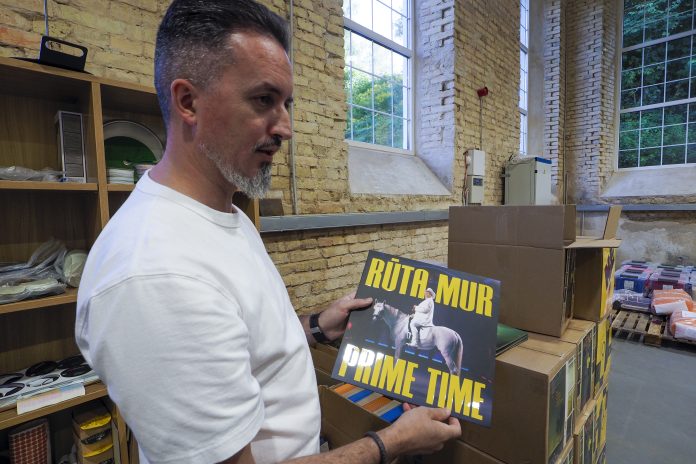When one of the most famous Lithuanian music producers, Lauras Lučiūnas, decided to start producing vinyl records, many had doubts about such plans. However, half a year was enough for the new business to get on its feet, says the journalist Vakaris Deksnys.
During Soviet times, most of the records in vinyl format reached the Baltic states from Riga, where the “Melodija” factory was located. Afterwards, vinyl was forgotten; however, the renaissance of such records began more than a decade ago.
For some time Lithuanians kept away – “Semikols Record Pressing” was established earlier in Latvia and in Estonia – “Vinyl Plant LLC”. There are about 160 of such factories around the world.
However, there were not enough of them, at least for the producer of famous Lithuanian artists, Lauras Lučiūnas. “The amount of time it would take others to produce them sucked. Some would be working way too slowly and others would make mistakes.
“We were once driving together with Antanas Kamenskas, who is now running the factory, and were caught by emotions of anger – what the hell, why does it take them nine months to produce anything? Imagine this, an artist records their album but the vinyl record is only available after more than half a year. He had some analysis done and found out who produced the equipment, as well as what the prices and deadlines were.
We sent requests and did some research on the market until we finally decided that the German equipment was the best. We wrote to them and they suggested going to Belgium to check out how their equipment worked. We thought that no one would accept us – we were potential competitors after all. But they gladly welcomed us, and showed us how everything worked.
The manufacturers told us when they would give us the equipment and sent us some spreadsheets of prices and how much time it would take to become beneficial. We found and repaired the premises ourselves, and that is how everything began,” says L. Lučiūnas.
The “Green Lakes Pressing” factory, set in the territory of a former paper factory, is not named this way by accident – close by is a recreation area loved by the people of Vilnius, with huge water bodies called the Green Lakes (lit. Žalieji ežerai).
“Green Lakes Pressing” is also “green” due to the production process. The equipment is already brought here and it allows us to recycle the waste from vinyl production. Moreover, bioplastic is used to produce it.
“Soon our factory will be a completely closed loop: waste will be recycled and used again. This is exactly what some of our customers request,” explains the founder of the company.
“Green Lakes Pressing” can already boast about having customers: the British independent record companies “Ninja Tune” and “The state51 conspiracy” have their vinyl records produced here, and the super popular German DJ Paul van Dyk also ordered them.

Vinilo plokštelių gamykla
During half a year of the factory working, more than 110 records were released here, but the circulation was different – from a couple of hundred to a few thousand.
About 70 percent of the records are of Lithuanian artists, but, outside the local market, the company also aims for the West – Spain, Germany, Belgium, the United Kingdom, and the Netherlands. Estonian and Latvian artists have also produced their vinyl records here.
The records are produced in a semi-automatic way. Everything starts with a recording that is sent to the partners in the United Kingdom. Over there, in a laboratory, the sound is analogically transferred to a stamp. While the latter costs a few hundred euros, two of them are needed for both sides of the record, and with one set you can press around one thousand records.
The stamp brought to the factory is put into a press machine as a vinyl blank, which the employees call a “cake”. Then everything is closed and the press machine prepares the product, first with hot, later with cold, and at the end with hot gas again.
The production of a record takes about half a minute. When taken out, it is observed, checked and if a defect is noticed, the product is put aside. The right record is cut, paper labels are pressed on both its sides, and after that packaging awaits.
L. Lučiūnas says that some banks did not even believe in this business project because the field was new to Lithuania. However, one of them agreed to finance the factory. The investments totalled about a million euros. Within half a year, the company reached a state where it earned its own money and investments were almost no longer necessary.
According to the music producer, the market of vinyl records is still expanding – although its growth is slower than a decade ago, it is still rather solid, and in the United Kingdom and the United States vinyl has outgrown CDs.
“Recently, the latest album of the American artist Taylor Swift was released as a vinyl record too – more than a million copies were sold. Fans who bought the record also buy record players. And when you already have a record player, you won’t just play one record, right?
In some Lithuanian stores or bookstores, you can already find vinyl sections that were not there before. Recently, I went to a store next to the factory simply to buy some water. And what did I see there – even two record players; one was more expensive, and the other was cheaper. Not bad,” says L. Lučiūnas.

